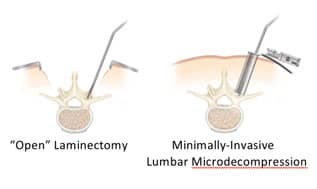This website uses cookies so that we can provide you with the best user experience possible. Cookie information is stored in your browser and performs functions such as recognising you when you return to our website and helping our team to understand which sections of the website you find most interesting and useful.

A Minimally Invasive Laminectomy/Discectomy is a surgical procedure designed to alleviate pain and other symptoms caused by spinal pressure. This operation is a less invasive alternative to traditional open spine surgery and focuses on treating conditions affecting the spinal cord or the nerves that pass through the spine.
Understanding the Spine:
To appreciate this surgery, one must understand the spine’s anatomy. The spine is made up of bones called vertebrae, separated by discs that act as shock absorbers. The spinal cord runs through a canal in the center of these vertebrae, and nerve roots branch out from this canal.
Conditions Treated:
This procedure often treats conditions like herniated discs, spinal stenosis (narrowing of the spinal canal), and other disorders causing nerve compression. These conditions can lead to symptoms like pain, numbness, and weakness in the arms or legs.
The Procedure:
- Minimally Invasive Approach: Unlike traditional surgery, which requires a long incision to open up the area, minimally invasive techniques involve smaller incisions. This approach reduces damage to surrounding tissues.
- Laminectomy: This part involves removing a portion of the lamina, the back part of the vertebra that covers the spinal canal. This is done to create more space and relieve pressure on the nerves or spinal cord.
- Discectomy: If a herniated disc is causing nerve compression, part of the disc may be removed during a discectomy. This is often performed in conjunction with a laminectomy if the disc is contributing to the narrowing of the spinal canal.

Advantages:
- Less Traumatic: Smaller incisions mean less damage to surrounding muscles and tissues.
- Reduced Pain and Faster Recovery: Patients often experience less post-operative pain and a quicker return to normal activities.
- Lower Risk of Infection: Smaller incisions reduce the risk of infections.
Risks and Considerations:
Like all surgeries, a minimally invasive laminectomy/discectomy carries risks such as infection, bleeding, nerve damage, or a lack of symptom relief. Therefore, it’s crucial for patients to discuss the potential benefits and risks with their surgeon.
Conclusion:
A minimally invasive laminectomy/discectomy can be a beneficial option for individuals suffering from certain spinal conditions. By understanding the procedure and its implications, patients can make informed decisions about their spinal health. Always consult with a qualified healthcare professional to determine the best course of action for your specific condition.
Want to get the latest Awake Spinal Fusion updates?

